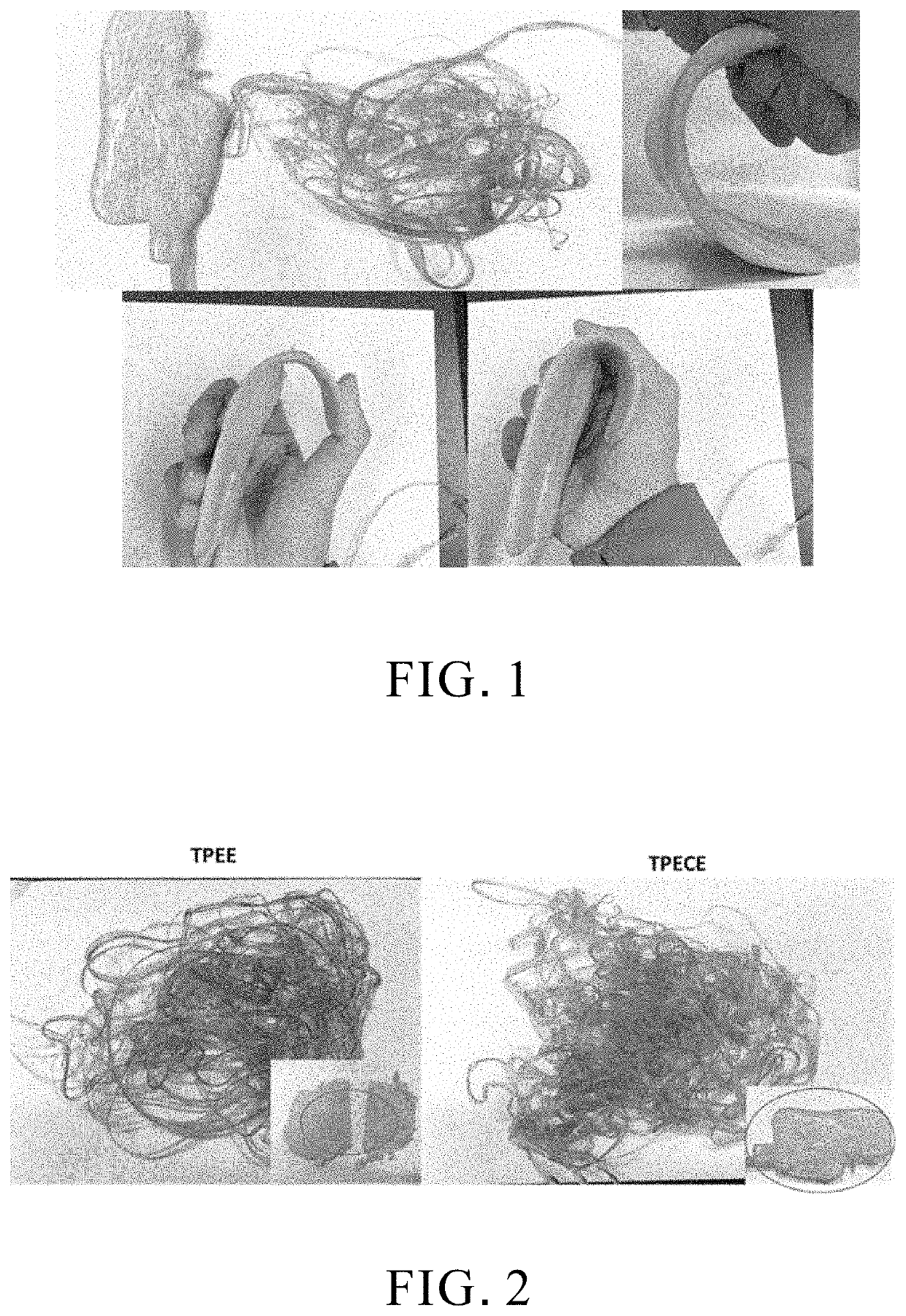Oligomer or polymer with carbonate segment chemical structure
a carbonate and polymer technology, applied in the field of oligomers or polymers, can solve the problems of difficult production of cyclic carbonate with a ring of six or more than, high toxicity of phosgene used in phosgenation process, and high difficulty in synthesis, and achieve excellent physical and chemical properties
- Summary
- Abstract
- Description
- Claims
- Application Information
AI Technical Summary
Benefits of technology
Problems solved by technology
Method used
Image
Examples
embodiment 1
[0054] thermoplastic elastomer of r-PET / PTMEG / EC (weight ratio: 68 / 29 / 3).
[0055]In embodiment 1, the weight ratio of polytetramethylene ether glycol (PTMEG) to polyethylene terephthalate (PET) is 30:70, and, in the presence of 2.7 wt % ethylene carbonate (EC) (molar ratio of PTMEG to EC is 1:1), thermoplastic ester carbonate elastomer (TPECE) is produced.
[0056]In embodiment 1, the process flow of producing the thermoplastic elastomer is described below.
[0057]A three-necked reactor with a mechanical blender, heater, Dean-Stark Trap, water-cooled condenser and vacuum pump is filled with PTMEG-1000 (105 g, 0.105 mole), EC (9.24 g, 0.105 mole) and titanium (which functions as a catalyst and measures 400 ppm in concentration when compared with the weight of the end product). Then, the three-necked reactor is heated to 150° C. In a blending process, some recycled PET scraps (245 g) are introduced into the three-necked reactor batch by batch. In a blending and heating process, sheets of the...
embodiment 2
[0059] thermoplastic elastomer of r-PET / PTMEG (weight ratio: 70 / 30).
[0060]In embodiment 2, weight ratio of polytetramethylene ether glycol (PTMEG) to polyethylene terephthalate (PET) is 30:70, for example, such that thermoplastic ester elastomer (TPEE) is produced.
[0061]In embodiment 2, the process flow of producing the thermoplastic elastomer is described below.
[0062]A three-necked reactor with a mechanical blender, heater, Dean-Stark Trap, water-cooled condenser and vacuum pump is filled with PTMEG-1000 (105 g, 0.105 mole) and titanium (which functions as a catalyst and measures 300 ppm in concentration when compared with the weight of the end product). Then, the three-necked reactor is heated to 150° C. In a blending process, some recycled PET scraps (245 g) are introduced into the three-necked reactor batch by batch. In a blending and heating process, sheets of the PET scraps are dissolved gradually such that more sheets can be introduced. The PET scraps are introduced batch by ...
embodiment 3
[0065] in the presence of PTMEG-650 with a molecular weight of 650, with a weight ratio of PET / PTMEG being 70:30, for example, 2.7 wt % EC is introduced, so as to produce TPECE.
PUM
| Property | Measurement | Unit |
|---|---|---|
| weight | aaaaa | aaaaa |
| weight | aaaaa | aaaaa |
| temperature | aaaaa | aaaaa |
Abstract
Description
Claims
Application Information
 Login to View More
Login to View More - R&D
- Intellectual Property
- Life Sciences
- Materials
- Tech Scout
- Unparalleled Data Quality
- Higher Quality Content
- 60% Fewer Hallucinations
Browse by: Latest US Patents, China's latest patents, Technical Efficacy Thesaurus, Application Domain, Technology Topic, Popular Technical Reports.
© 2025 PatSnap. All rights reserved.Legal|Privacy policy|Modern Slavery Act Transparency Statement|Sitemap|About US| Contact US: help@patsnap.com



